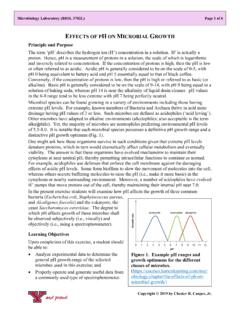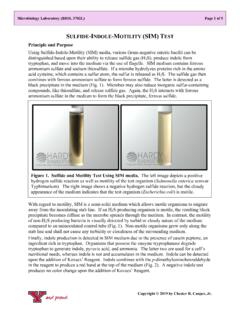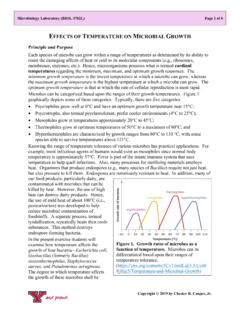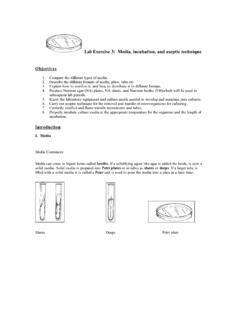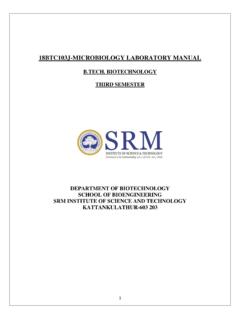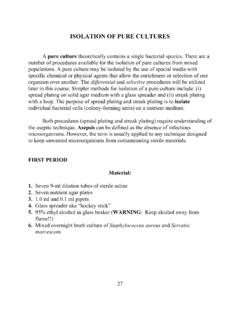Transcription of GELATIN HYDROLYSIS TEST
1 Copyright 2019 by Chester R. Cooper, Jr. Microbiology Laboratory (BIOL 3702L) Page 1 of 3 GELATIN HYDROLYSIS TEST Principle and Purpose GELATIN is a soluble mixture of polypeptides derived from the collagen of animal connective tissues. A common dessert beloved by children is Jello, which is comprised of GELATIN ( ; Hence, vegans or vegetarian might think twice before eating that fruit salad Jello!) At warmer temperatures, GELATIN exists in a semi-liquidized state. At cooler temperatures, however, the polypeptide nature of GELATIN causes it to be semi-solid. Again, when making Jello, the heated, liquid mixture is placed into a mold (perhaps with fruit chunks), then place the mold in the refrigerator to cause the Jello to solidify and, viol , a tasty, refreshing dessert is formed! In the microbiology laboratory, GELATIN can be used to not only help identify bacteria, but also to assess their potential pathogenicity.
2 Certain bacteria, particularly pathogens, secrete a proteinase (gelatinase) that hydrolyzes the polypeptides of GELATIN . As a consequence, the amino acids released by this digestive process can serve as a nutritional source for these microbes. However, the hydrolytic activity of gelatinase prohibits the solidification of the polypeptides that normally occurs at cooler temperatures (Fig. 1). In addition, the ability to secrete gelatinase is often correlated with the microbe s capacity to break down tissue collagen, thereby aiding in the spread of the pathogen within a host. In essence, gelatinase production by a microbe may contribute to its potential to initiate infection. The following simple exercise employs a GELATIN -based medium to determine if the bacterium being tested possesses the ability to secrete gelatinase. Learning Objectives Upon completion of this exercise, a student should be able to: Understand the underlying basis of the gelatinase test; Properly conduct the gelatinase test; and Accurately interpret the results of this test.
3 Figure 1. Gelatinase Test Results. Pseudomonas aeruginosa (top), Escherichia coli (middle), and Serratia marcescens (bottom) were inoculated into nutrient GELATIN agar. The agar in the Pseudomonas aeruginosa and Serratia marcescens tubes remained liquid indicating gelatinase digestion of GELATIN . The Escherichia coli culture remained solidified indicating that gelatinase was not produced. The red color in the agar is due to the pigment produced by Serratia marcescens. Copyright 2019 by Chester R. Cooper, Jr. GELATIN HYDROLYSIS Test, Page 2 of 3 Materials Required The following materials are necessary to successfully conduct this exercise: Organisms - The following organisms should be provided as 24-48 hour-old TSB cultures: Enterobacter aerogenes (ATCC 13048) [abbreviated as Ent. aerogenes] Escherichia coli (ATCC 25922) [abbreviated as E. coli] Staphylococcus aureus (ATCC 25923) [abbreviated as S.]
4 Aureus] Staphylococcus epidermidis (ATCC 12228) [abbreviated as S. epidermidis] Media Nutrient GELATIN deeps Procedure Students shall review and use the BIOL 3702L Standard Practices regarding the labeling, incubation , and disposal of materials. 1) Obtain five (5) nutrient GELATIN deep tubes. Label one tube for inoculation with S. aureus, another to be inoculated with S. epidermidis, a third labeled for E. coli, and a fourth to be inoculated with Ent. aerogenes. The remaining fifth tube should be labeled as Control and will not be inoculated with any bacterium. 2) Using aseptic technique and a microbiology needle, inoculate the respective tube with the appropriate bacterium by stabbing the medium three-fourths of the way to the bottom of the tube. 3) Incubate all tubes for 1 to 7 days at 37 C. 4) Periodically throughout the incubation period, remove the tubes from the incubator and place them at 4 C ( , a refrigerator) for 30 minutes.
5 Alternatively, the tubes can be placed in an ice bath for 5-10 minutes. 5) After cooling, place the tubes in a slanted position. Interpretation of Results: Observe if slanting of the tube causes the surface of the medium to be fluid/liquid. Such conditions indicate that the GELATIN has been hydrolyzed (a positive result for the production of gelatinase; Fig. 1). If the GELATIN has not been hydrolyzed (a negative result), the medium will appear to remain as a semi-solid gel. The Control tube should exhibit a negative gelatinase result. Note: Any tube exhibiting a negative result should be further incubated up to a total of 7 days. to be certain the organism being tested does not produce gelatinase. If the organism is suspected to be a Proteus species, incubation should continue up to 14 days. Record any observations on the data report sheet attached to this document. Copyright 2019 by Chester R.
6 Cooper, Jr. GELATIN HYDROLYSIS Test, Page 3 of 3 Student Name: GELATINASE TEST For the control and each species listed below, indicate with a + if GELATIN has been hydrolyzed (a positive result) or a - if it has not (a negative result). Be sure to indicate the number of hours of that the nutrient GELATIN deep had been incubated prior to assessing HYDROLYSIS . Students may wish to assess HYDROLYSIS at several time points. Production of Gelatinase by Selected Microbes Organism Hours of incubation Control (uninoculated) Staphylococcus aureus Staphylococcus epidermidis Enterobacter aerogenes Escherichia coli Literature Research Using a published, peer-reviewed scientific literature source focused on the role of gelatinase by one or more microbes, summarize the findings of this article in 3-5 sentences to be written in the space below. Do not copy (plagiarize) the abstract or other content of this article!
7 Use your own words/thoughts. In addition, attach a photocopy of the front page of this article to this report. Staple Here Staple Here




